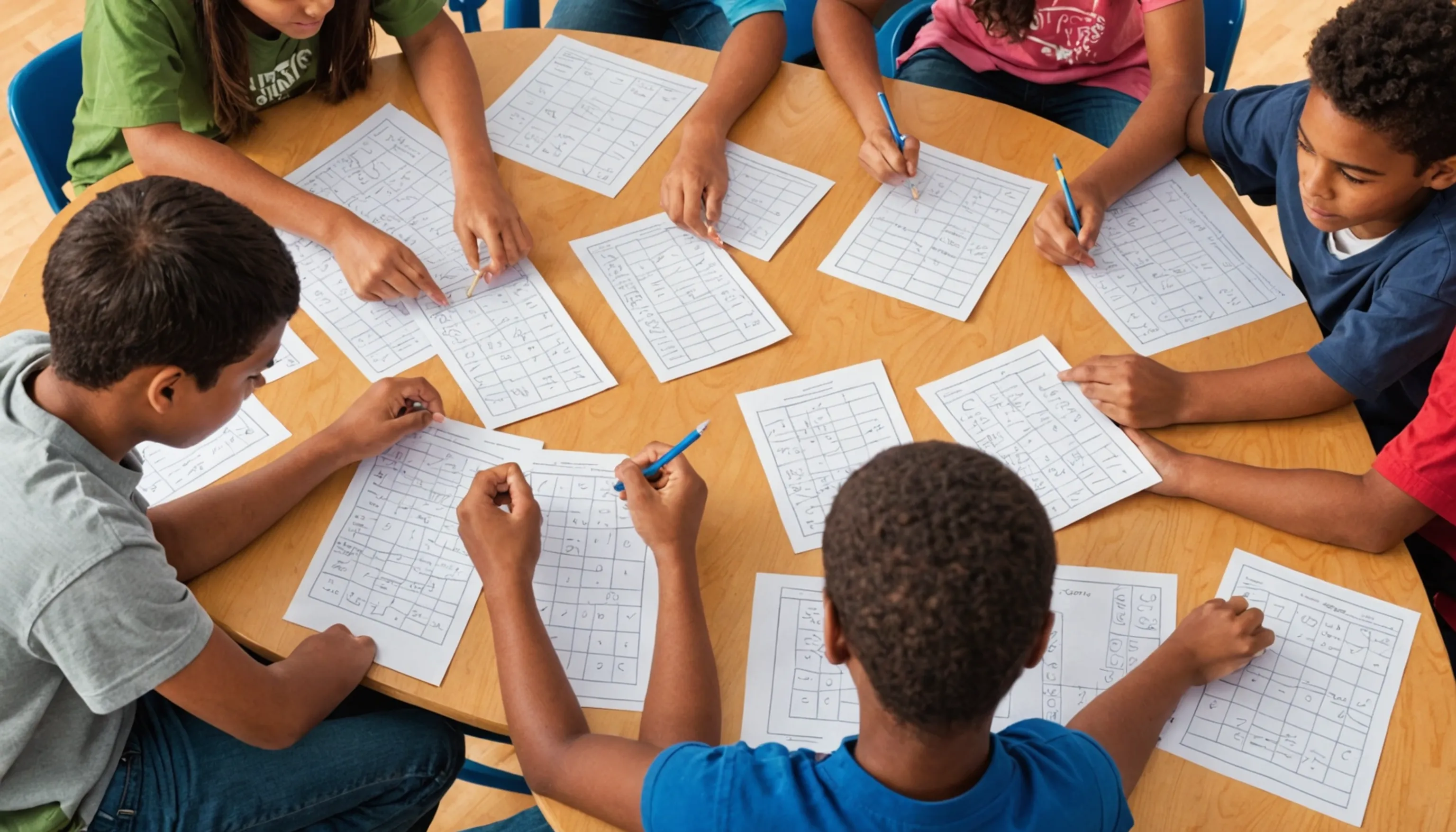Fun After-School Math Challenges for Students
 HvWHenry van Wagenberg
HvWHenry van Wagenberg
Engaging After-School Math Challenges for Students
Engaging after-school math challenges for students can transform mundane homework into an exciting learning experience. These challenges not only reinforce math skills but also foster critical thinking and problem-solving abilities. Parents & teachers can create a variety of engaging activities, such as:
- Puzzles that require logic and reasoning
- Real-world problems that relate to daily life scenarios
- Interactive games that utilize technology and online resources
By incorporating these fun challenges, students can develop a love for math while enhancing their skills in a relaxed & enjoyable environment.
Why Math Challenges are Beneficial for Teenagers
Math challenges offer numerous benefits for teenagers, making them an essential part of after-school activities. First & foremost, they enhance problem-solving skills. By engaging in various types of challenges, students learn to approach problems from different angles, fostering creativity & critical thinking.
Additionally, math challenges help to build confidence. As teenagers successfully complete these challenges, they gain a sense of achievement that boosts their self-esteem. This newfound confidence can translate into improved performance in the classroom, as students feel more capable of tackling complex mathematical concepts.
Another significant benefit of math challenges is the development of teamwork skills. When students participate in group challenges, they learn to communicate effectively, share ideas, and collaborate towards a common goal. These interpersonal skills are crucial not only in mathematics but also in various aspects of life.
Furthermore, math challenges can make learning more enjoyable. By introducing elements of fun and competition, students are more likely to engage with the material and develop a genuine interest in mathematics. This positive attitude can lead to a lifelong appreciation for the subject.
Finally, math challenges often incorporate real-world applications, helping teenagers understand the relevance of mathematics in their everyday lives. By solving practical problems, they can see how math is not just an abstract concept but a valuable tool they can use in various situations.
Types of Fun Math Challenges
There are various types of fun math challenges that can engage students and make learning enjoyable. Here are some popular categories:
- Puzzle-based challenges: These include logic puzzles and brain teasers that require critical thinking to solve, such as Sudoku or cross-number puzzles.
- Real-world math problems: These challenges relate mathematical concepts to everyday situations, like budgeting for a school event or calculating distances for a trip.
- Interactive online math games: Websites & apps offer engaging math games that promote skill development through play, making learning fun and competitive.
- Math scavenger hunts: Students can work in teams to solve clues that lead them to various locations, combining physical activity with problem-solving.
By incorporating these diverse challenges, educators & parents can spark a genuine interest in math among teenagers.

Puzzle-based Challenges
Puzzle-based challenges are an exciting way to engage teenagers in mathematics while developing their critical thinking and problem-solving skills. These challenges come in various forms, each designed to stimulate the mind and encourage logical reasoning.
One popular type of puzzle is the logic puzzle, where students must deduce the correct answer based on a set of clues. For example, a classic logic grid puzzle may involve determining which student owns which pet based on given statements. This type of challenge enhances deductive reasoning and attention to detail.
Sudoku is another favorite puzzle that combines numbers and logic. By filling a 9x9 grid with digits 1-9 without repeating numbers in any row, column, or 3x3 subgrid, students practice their problem-solving skills and develop a systematic approach to finding solutions.
Crossword-style math puzzles also offer a fun twist on traditional math problems. Students fill in a grid with numbers or equations based on provided definitions or clues, reinforcing their math vocabulary and concepts.
Finally, escape room puzzles can be created for classrooms, where students solve math-based riddles to unlock clues and "escape" within a time limit. This collaborative experience fosters teamwork and communication skills while making math a thrilling adventure.
Real-world Math Problems
Real-world math problems are an effective way to engage teenagers by demonstrating how mathematics applies to everyday life. These challenges encourage students to think critically and use their math skills to solve practical issues they may encounter in various situations.
One common example is budgeting. Students can be tasked with planning a budget for a school event or a personal project. This challenge requires them to calculate expenses, allocate funds, and make decisions on how to maximize their resources. Such problems not only reinforce arithmetic skills but also teach valuable financial literacy.
Another engaging real-world math problem involves measuring distances and time. Students might calculate the time it takes to travel to a specific location, considering factors like speed and distance. This can be made interactive by incorporating a mapping activity where they plot routes and analyze data.
Additionally, recipe adjustments present a fun way to apply math in cooking. Students can modify a recipe based on the number of servings required, using ratios and proportions to ensure the correct ingredient amounts.
Lastly, challenges related to sports statistics can capture students' interests. Analyzing player performance, calculating averages, or predicting outcomes based on historical data can turn math into a thrilling exploration of their favorite sports.
By incorporating real-world math problems, educators can help students see the relevance of mathematics in their daily lives, making learning more meaningful and enjoyable.
Interactive Online Math Games
Interactive online math games have become a popular tool for engaging teenagers in mathematics while making learning enjoyable. These games provide a dynamic way for students to practice their skills, reinforcing concepts through play and competition.
Many online platforms offer a variety of math games that cater to different skill levels and topics. For instance, platforms like Prodigy Math allow students to embark on adventures where they solve math problems to progress through levels. This gamification approach motivates students to improve their math skills while having fun.
Another engaging option is Kahoot!, which enables teachers to create interactive quizzes where students compete against each other in real-time. This format encourages healthy competition and collaboration among peers, making it an exciting way to reinforce classroom learning.
Math Blaster is another classic example, where students complete math challenges to rescue characters in a futuristic setting. This game combines fast-paced action with mathematical problem-solving, capturing the attention of students who enjoy video game mechanics.
Furthermore, interactive games can also be found on websites like Coolmath Games, which offers a wide range of math-related puzzles and brain teasers. These games focus on logic, strategy, and critical thinking, encouraging students to approach math in a less traditional format.
By integrating interactive online math games into after-school routines, educators and parents can create a fun, engaging environment that helps teenagers develop a strong foundation in mathematics while enjoying the learning process.

How to Create a Math Challenge Routine at Home
Creating a math challenge routine at home can be a rewarding experience for both parents and teenagers. Start by setting aside a specific time each week dedicated to math challenges, making it a fun family activity. Choose a mix of puzzle-based challenges, real-world math problems, and interactive online games to keep things engaging.
Encourage friendly competition by setting goals and offering small rewards for completing challenges. Incorporate technology by using math apps and websites that provide engaging content. Finally, involve your teenager in selecting challenges, ensuring they feel invested in the process!
Setting Goals and Rewards
Setting goals and rewards is an essential aspect of creating an effective math challenge routine at home. By establishing clear objectives, you can motivate teenagers to engage more deeply with math challenges and develop a sense of accomplishment.
Start by discussing with your teenager what specific math skills they want to improve. These could include mastering fractions, enhancing problem-solving abilities, or increasing speed in calculations. Once you have identified these goals, break them down into manageable milestones. For instance, if the goal is to improve speed in solving equations, set a target of completing a certain number of problems within a specific time frame.
Next, introduce a reward system to encourage progress. Rewards can range from simple incentives, like choosing a family movie night or enjoying a favorite snack, to more significant rewards, such as a new game or a special outing. The key is to ensure that the rewards are meaningful and motivating for your teenager.
Additionally, consider implementing a point system where students earn points for completing challenges or achieving milestones. Accumulated points can then be exchanged for rewards, creating an element of gamification in the learning process.
Regularly review the goals and progress with your teenager, celebrating their achievements and adjusting targets as needed. This ongoing dialogue fosters a supportive learning environment and reinforces the idea that effort and persistence lead to success in mathematics.
Incorporating Technology and Apps
Incorporating technology and apps into your math challenge routine can significantly enhance your teenager's learning experience. With numerous educational tools available, you can create an engaging environment that makes math both fun and interactive.
Start by exploring popular math apps designed specifically for teenagers. Apps like Khan Academy and Prodigy Math offer personalized learning experiences, allowing students to work at their own pace and tackle challenges tailored to their skill level. These platforms provide instant feedback, helping students identify areas for improvement.
Another excellent option is Mathway, which enables students to input math problems and receive step-by-step solutions. This feature not only helps them understand the process behind the solution but also allows for independent problem-solving.
Additionally, consider using online platforms like IXL or Coolmath Games, which provide a wide range of interactive exercises and games. These resources can make learning more enjoyable, as students can explore different math concepts while playing games that challenge their skills.
Moreover, incorporating video tutorials from platforms like YouTube can offer visual explanations of complex topics, making it easier for students to grasp challenging concepts. Encourage your teenager to seek out educational channels that focus on math topics they find difficult.
By integrating technology and apps into your math routine, you can create a dynamic learning atmosphere that encourages your teenager to embrace math challenges with enthusiasm.
Encouraging Group Challenges with Friends
Encouraging group challenges with friends can significantly enhance your teenager's engagement with math challenges while fostering social skills and teamwork. Collaborative learning not only makes math more enjoyable but also allows students to share diverse problem-solving strategies and perspectives.
To initiate group challenges, start by organizing regular math challenge meet-ups, either in person or virtually. Use platforms like Zoom or Google Meet to connect with friends if meeting in person isn’t feasible. Create a schedule that allows everyone to participate, ensuring it fits within their availability.
During these meet-ups, present a variety of math challenges, such as puzzle-based problems, real-world scenarios, or interactive games. Encourage each participant to contribute ideas and solutions, as this collaboration will deepen their understanding of mathematical concepts. You could also introduce a friendly competition format, where teams earn points for completing challenges correctly and quickly.
In addition, consider utilizing online resources that facilitate group challenges. Websites like Kahoot! allow users to create quizzes that friends can compete in, promoting a fun and interactive atmosphere. This gamified approach keeps students motivated and engaged while they learn.
Finally, celebrate their achievements as a group. Whether it’s through small rewards, certificates, or simply recognizing their hard work, acknowledging their efforts will encourage continued participation in math challenges. By fostering a sense of camaraderie and support, students are more likely to embrace math as a fun and rewarding subject.
